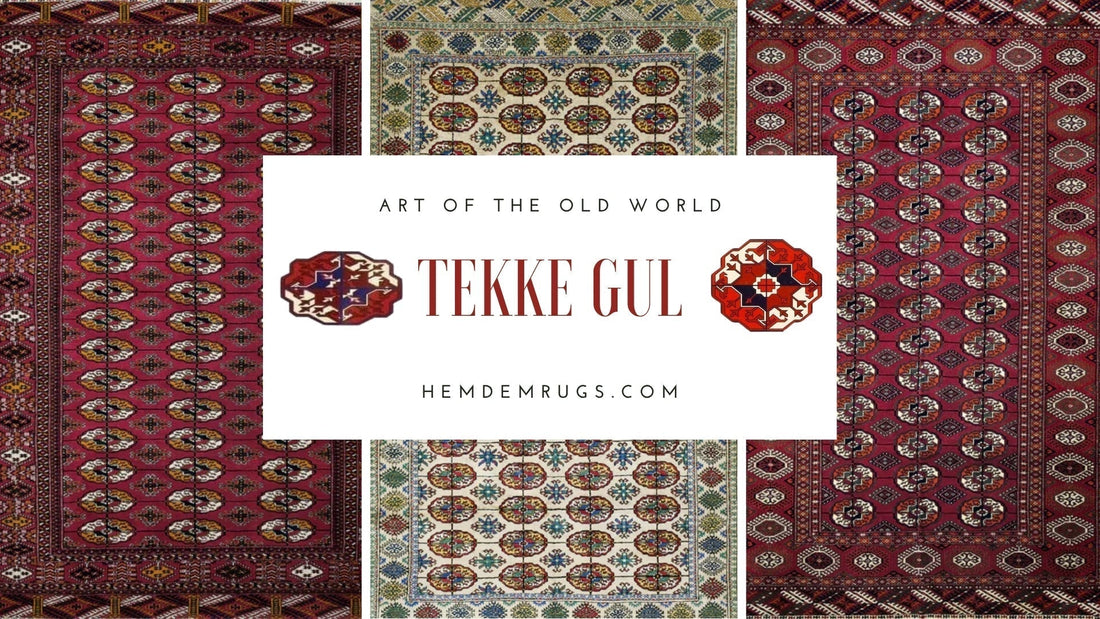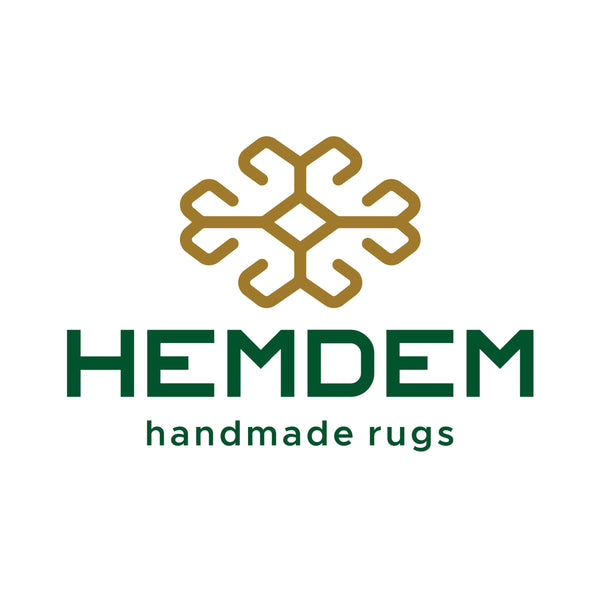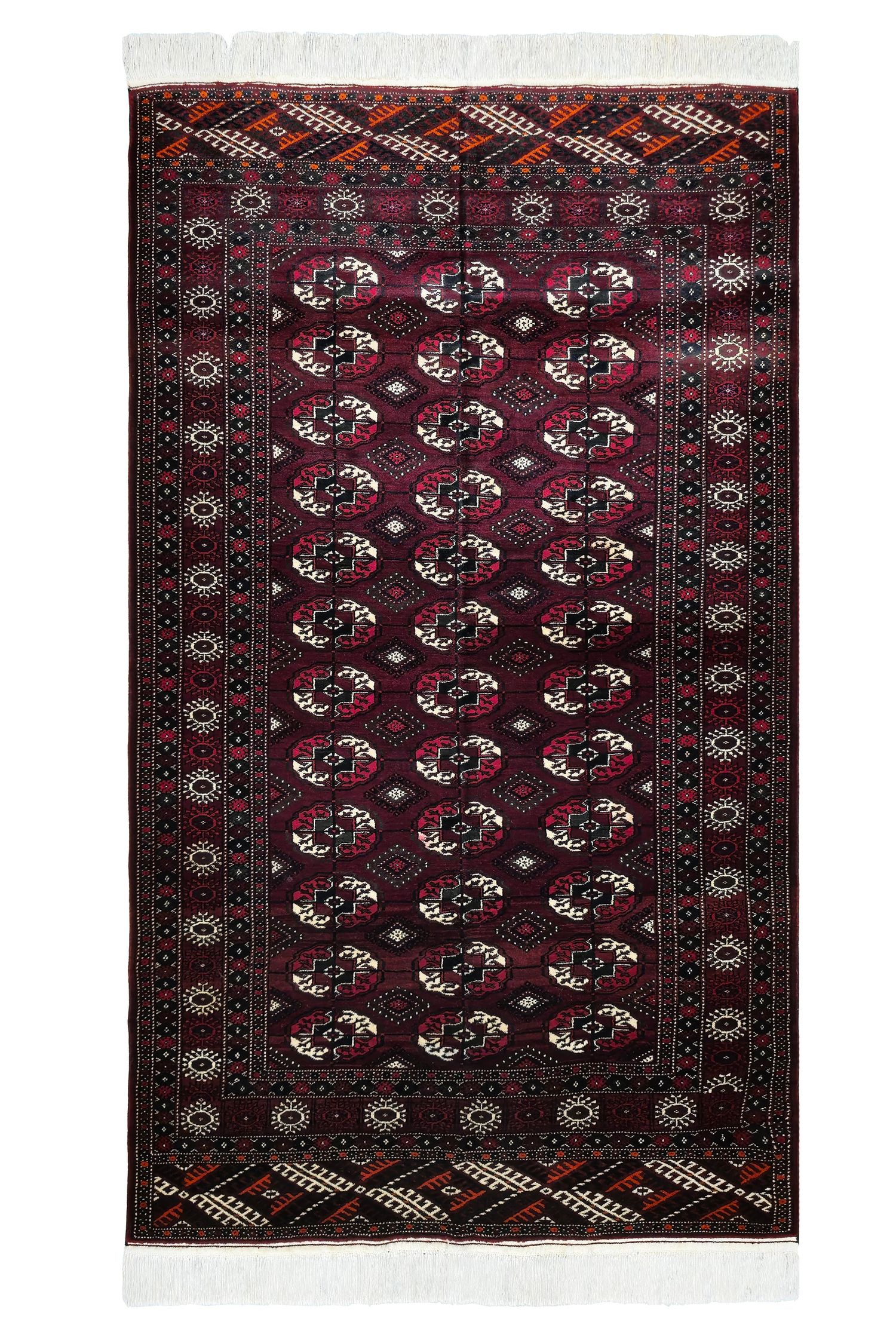
Tekke Gul The Woven Heritage of Turkmen Culture
Tekke Rugs: The Woven Heritage of Turkmen Culture
Rugs are more than just floor coverings; they are artistic creations reflecting the history, culture, and lifestyle of the societies that weave them. Among these, the Tekke rugs stand out with their rich patterns and deep-rooted history, representing one of the most prized examples of Turkmen weaving.

Discover Our Tekke Rugs Collection
Geographic and Tribal Origins: The Touch of a Nomadic Spirit
Tekke Turkmen rugs are named after the Tekke tribes who once lived in northern Afghanistan and former USSR territories [Rug Guru, 205]. Turkmens traditionally inhabited a vast region in Western Turkestan, stretching from the Caspian Sea’s eastern shores to the Kopet-Dag Mountains and the foothills of the Hindu Kush. This region is also home to other Turkic-speaking groups such as Uzbeks, Karakalpaks, and Kyrgyz [Rug Guru, 200, 201].
Historical research clearly traces the origins of the Tekke tribes to the Oghuz Turks. The Oghuz descendants include major dynasties such as the Seljuks and Ottomans [Rug Guru, 202]. This deep historical connection reveals that Tekke rugs are not merely objects, but vessels of a rich cultural legacy. The nomadic or semi-nomadic lifestyles of the Turkmen people enabled them to preserve their unique culture and weaving traditions over centuries. This lifestyle also led some groups to migrate toward Afghanistan, Iran, or even the Himalayan foothills over time [Rug Guru, 202, 204].
Value and Function: From Tent Door to Art Object
Tekke Turkmen rugs are generally considered more valuable than rugs of similar quality produced in workshops in Pakistan [Rug Guru, 205]. This value stems both from their authentic origin and the fine craftsmanship in their weaving.
A special type of rug woven by Turkmen tribes called ensi (or engsi) is particularly notable. These were originally designed as inner tent doors [Rug Guru, 209]. In nomadic life, rugs served not only as insulation against cold but were also used as covers or blankets [Rug Guru, 204].
Technical Features and Structure: A Story in Every Knot
The technical composition of Tekke rugs defines their durability and unique appearance:
-
Knot Type: Tekke rugs are usually woven using the asymmetrical right-opening knot technique [Stone, 53, 27]. However, symmetrical knots can also be seen in general Turkmen rugs [Stone, 27; Rug Guru, 261].
-
Knot Density: One source indicates that a Tekke rug may have a knot density of 152 knots per square inch (2,432 knots per square decimeter) [Stone, 53, 131]. For other Turkmen rugs, densities of 80 knots per square inch (1,280 per square decimeter) are also noted [Stone, 27]. These differences may reflect tribal variations or specific rug qualities.
-
Yarn Materials: The pile (surface) of the rugs is made of wool [Stone, 53, 131]. Warp yarns are 2-ply, Z-spun wool [Stone, 53, 131]. Weft yarns are single Z-spun and woven in two passes [Stone, 53, 131]. Goat hair may also be used for binding the edges [Rug Guru, 210]. Particularly valuable camel hair is preferred in prayer rugs [Rug Guru, 210]. The wool is obtained from sheep herds, then washed, dried, carded, and spun (an average person can spin about one kilogram of wool per day) [Rug Guru, 210].
-
Looms and Shape: Weaving is typically done on horizontal or ground looms [Rug Guru, 211]. These looms can be easily dismantled and transported to suit nomadic life. Frequent assembly and disassembly can cause varying tension in warp threads, which may result in irregular shapes—a hallmark of tribal rug charm [Rug Guru, 211].
Materials and Dyes: Nature’s Color Palette
The dyes used in Tekke rugs play a significant role in defining their character:
-
Natural and Synthetic Dyes: Although natural dyes are still used, synthetic dyed wool yarns have increasingly replaced or been used alongside them since the 1950s due to their easy availability [Rug Guru, 210].
-
Abrash Effect: Natural dyes fade beautifully over time and show irregular color variations known as abrash [Rug Guru, 210]. Abrash occurs when a weaver runs out of one batch of wool and must use another, creating a “mottled” or “marbled” appearance—highly prized in tribal weaving [Rug Guru, 210]. Synthetic dyes fade only at light-exposed tips [Rug Guru, 210].
Sources of Natural Dyes:
-
Reds: Derived from the madder root (ranging from red to orange and purple), cochineal (blue/red tones), lac (deep purple), kermes [Rug Guru, 210]. - Shop red rug
-
Blues: Indigo plant [Rug Guru, 210]. - Shop blue rug
-
Blacks: Obtained from tannic acid, oak galls, pomegranate rinds; adding iron sulfate stabilizes the color but can cause wear in black wool areas in rugs over 50–100 years old [Rug Guru, 211]. - Shop black rugs
-
Yellows: Sourced from weld, saffron, wild chamomile, sumac, buckthorn, and dyer’s greenweed [Rug Guru, 211].
-
Greens: Made from walnut and olive leaves [Rug Guru, 211]. - Shop green rugs
-
Browns: Derived from undyed natural wool or dyed with fresh/dried walnut husks, oak galls, and similar materials [Rug Guru, 211].
Conclusion: A Living Testament to Cultural Legacy
Tekke rugs are unique works of art that embody the enduring life, beliefs, and artistry of the Turkmen tribes. Every knot and motif whispers the hardships of nomadic life, the beauty of nature, and the legacy of ancestors. Even today, these rugs are valued not just as objects, but as a living art form and tangible proof of cultural continuity.



